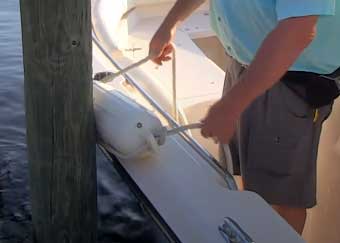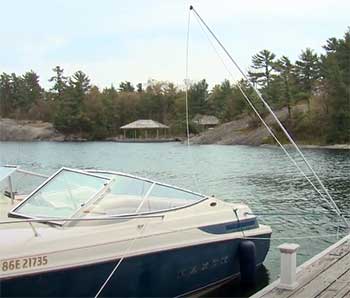Mooring whips have been proven to safeguard your dock and boat from damage. They are designed to offer the best protection to your boat while it’s not cruising. Plus, they make mooring and docking easier, safer, and more convenient.
But they are expensive and not many people want to make that sort of investment. If you still want maximum protection for your boat, then consider these alternatives to mooring whip.
Mooring Whip Substitutes To Secure your Boat
- Dock Edging

You can easily customize dock edging. Dock edging is simple to modify.
Simply cut the length you want and nail or screw it to the dock’s edge.
This technique is an excellent way to safeguard your boat from minor bumps and continuous rubbing caused by wave movement.
Where it falls short is in terms of effect. Despite the edging, if you crash into the pier, you will most certainly sustain damage. Dock edging works best when combined with other fending tactics.
Also Read: Differences Between Minn Kota Raptor And Power Pole.
- Piling Fenders
Sadly, piling fenders make docking your boat more difficult. Install fender boards to your boat if you wish to add pilings. When you’re out cruising on the waters, you may utilize fender boards.

We propose installing fixed bumpers on the piling if it was installed on the slip.
You may also pick piling bumpers to wrap all around the pilings.
Tires may be used here by laying them atop the piling before placing them down on the dock.
Alternatively, you can make a complete and working bumper if you have the right amount of tires.
Dock fenders may be used alongside dock edging to provide twice the security for your boat dock and boat.
You may put them from edge to edge or merely blanket the portions of the boat dock where your boat is most likely to impact when docking.
- Foam-Filled or Inflatable Dock Fenders
Foam-filled or inflatable dock fenders are available in a variety of forms, most notably straight sections, and 90° corners, while other angles are occasionally available.
Dock fenders reduce rubbing and impact. They absorb the blow rather than your boat.
They absorb the blow rather than your boat. in conjunction with dock edging to provide additional protection. They don’t have to be put from beginning to end but make sure to protect the regions where the boat is most likely to strike.
- Dock Wheels
Regular sailors are thankful for the incredible inventions that are dock wheels. They protect your boat from the dock while also aiding it inside the slip.
Dock wheels are typically available in 2 configurations: side mount and corner mount. Place one on each corner of your boat dock, and even better, install one on each side.
Set up 1 on every side and corner if there is a full slip. On a windy day, you’ll appreciate the ability to roll the boat.
- Anchors
Traditional anchors function by burrowing into the seafloor, but not too deeply, or you risk losing an anchor as well as a big amount of chain.
When the anchor hits the seabed’s bottom, you drop lengths of chain. The weight of the chain and anchor holds the boat together.
This is how most basic anchors function, however some designs, such as fixed anchors carrying buoys or tiny anchors made for rubber dinghies, may diverge significantly from this technique.
Furthermore, the gripping strength of different anchors varies based on their design.
If there is enough space, use one or two anchors on the opposite end of the boat. If you run the line in a loop, it is easy to retrieve.
A catenary weight assists in keeping the boat off the pier. We recommend not using this method in tidal waters.
- Dock Shock
A Dock Shock kit comes with two shocks to connect to your pontoon or boat to simplify docking. The heavy-duty shock cord absorbs destructive blows and jolts to the dock and boat caused by other boats or the wind.
The hook end can be used as a loop to pass over a dock post, through a cleat, or attach to your boat. This works nicely on pontoons.
- Dock Lines
Dock lines are simply ropes that hold a boat in position at the dock for temporary or short-term mooring. Made of nylon, these ropes are elastic, strong, and resistant to UV rays, abrasion, and rot.
The perfect dock line will be strong enough to secure your boat, light enough to retain its shock-absorbing traits, and bulky enough to stop rubbing.
The size and architecture of your waterfront will also be determined by how exposed it is to wind, current, boat displacement, and waves.
Boats are often “made fast” to the dock with a set of 4 dock lines that combine to keep the boat in position: stern and bow lines, short breast lines, and spring lines. Depending on the weather and the sort of pier you’re connected to, lines may be reduced or lengthened.
- Tires
We can always rely on a good set of tires. Tires may be found in a variety of marinas and are fairly helpful against impact. Tire reuse is also environmentally-friendly as it prolongs the service life and before they end up in a landfill.
The biggest disadvantage of tires would be that they severely scuff fiberglass. Boat fenders are essential for keeping your boat from clashing against tires once docked, particularly if the hull is finely polished fiberglass.
Tires need to be arranged close together and go around the slip or dock’s length. You may even fashion a functional corner bumper from a tire.
Also Read: Differences Between Wave Armor And EZ Dock.
Are Mooring Whips Worth It?

Mooring whips are vital for keeping your cherished item safe and sound if you keep it moored behind your home.
Even the most robust dock lines and an array of fenders will not keep your boat from “bouncing” against the dock, thus jeopardizing its smooth finish.
Stirs from approaching boats and windy weather could gradually scuff and perhaps ruin the rub rail or, worse, your pricey Gelcoat if not protected.
In truth, barnacle-encrusted, jarred concrete seawalls and pilings are brutal.
Frequently Asked Questions (FAQs)
You can make mooring whips at home using PVC pipes and by tying a rope at the end of it. But we highly recommend you buy professionally made mooring whips for the best results.
The best method is using mooring whips but you can also use dock fenders for the job.
A boat whip system is an optimum option for protected marinas, lakes, low-wake zones, and canals.
Mooring whips are an inexpensive solution to shield your boat from seawall and boat-side damage. A mooring whip system safely and conveniently draws your boat away from the dock, safeguarding it from the harmful impacts of wind, tides, waves, and wakes.
Bottom Line
Dock fenders and bumpers are a great way to keep your boat from crashing into the boat dock. Choose them based on your boat dock’s design, boat’s length, and lake and weather conditions.
Feel free to combine a range of bumpers and fenders to create the best solution. That is all on mooring whip alternatives. Stay safe out there, folks!


